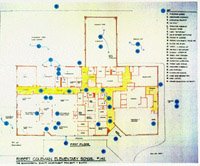 Left, a Helio Display
Left, a Helio DisplayMeeting: May 19, 2006
Speaker: Tom Moher, Department of Computer Science University of Illinois
"Ubiquitous Computing"
Location: Harvard Graduate School of Design
Attendees: S. Pollalis, J. Nichols, S. Pobiner, W. Kimm, MIKAEL POWELL(recorder), A. Hopper, J. Jungclaus, T. Shafer
The following constitutes an understanding of the lecture and discussion as compiled by Mikael Powell.
I. Mr. Moher’s work focuses exclusively on design spaces for education. He introduced the following terms:
Phenomenaria- Classroom areas where phenomena are made available for children to observe and manipulate. Common elementary school phenomenaria are ant farms, gerbil cages, etc… They provide access to experiences that do not naturally occur in the classroom. Like physical phenomenaria, computer simulations can serve a similar function.
Embedded phenomena- simulations that map dynamic science phenomena to the physical space of classrooms, and allow students to act as scientists by using computers as simulated instruments for measuring or viewing those phenomena.
II. His efforts concern trying to embed phenomena in the classroom within the confines of technology already in school. Embedded spaces are distributed throughout the class in portals. The simulations are persistent and enduring, running concurrently, but asynchronously. With respect to the regular instructional flow, students conduct investigations of the phenomena by monitoring and manipulating of the state of simulation via the media.
III. Mr. Moher, as well as Mr. C. Wisneski at Northwestern University actively research simulation technologies such as virtual environments, participatory simulations, physical and tangible interfaces, ambient media and mixed reality. Mr. Moher’s described several types of learning - Social (when we learn from each other), Episodic (distributed learning over time) and Opportunistic (not synchronized with instruction).
Simulations:
IV. The Bee Dance Students experience a graphical simulation of the honeybee dance presented on a plasma panel.
V. Room bugs The classroom was designed as a farming community and the goal is to attract the good bugs and repel the bad bugs. The media is sand traps containing bug tracks and the activity is to determine the local bug population from tracks so one may introduce pesticides to repel bugs.
VI. Helioroom http://www.optiputer.net
/publications/articles/THOMPSON-ICLS-
HelioRoom.pdf#search=%22phenomenaria%22 Developed for 3rd graders, HelioRoom simulates the orbits of the planets in the Solar system on a set of synchronized computer displays located on classroom walls. Students are required to determine the identity of planets and observe a planetary occlusion and differences in orbital periods.
VII. Room quake A classroom is augmented using a "thin layer of computation" for the purpose of allowing students to gain experience in the practice of locating the epicenter and magnitude of earthquakes. Students use simulated instruments, simple tools, and physical movement to determine epicenter and magnitude, and record the event by hanging Styrofoam balls from the classroom ceiling. This is an example of an Embedded Phenomena made “visible" through devices scattered around the room.
VIII. Mr. Moher presented the questions “At what extent are these games, verses non-games (educational technology)? There are some simulations that are not technology based at all. Does that make them a game?” He further responded that determination of educational value is reliant upon the opinion of school administrators and their degree of support.
IX. When asked about emerging technology, Mr. Moher responded as follows:
An interesting concept would be to turn drywall into pixel displays. If all the walls consisted of display technology then you do not have to move things around. A step up would be to move from displays to embedding technology into partitions (per Mark Reisnik [sp?]) that perform ubiquitous computation to portable displays. i.e. different displays for different sizes – a bin full of tangible controlling devices etc… Then you can connect to them by sticking to the wall.
Another innovation would be indoor tracking (being able to track individuals in the classroom). Now students go outdoors to use GPS, i.e. the equator project at the University of Nottingham in the UK. Students walk around with Wifi devices like animal in play. They overlay an African savannah layout. Right now we know their physical positions to a relatively low resolution. If we can master the technology to know where everyone is at all times, then that would be a great advancement. We would also need to improve video camera technology.
Our goal is to connect different classrooms together and classrooms from different schools. Asynchronous connections are exciting too. We would like to imbed learning style information into the embedded technology. If you provide environment to do ubiquitous technology, then it is possible.
If we were working with an architect and designing a new classroom prototype I would explore using the walls as displays (in fixed position or built into the partition). The next level up would be to have more flexibility on the attachment of LCD displays or organic LCD displays. Something pegboard-ish or magnetic. And I am talking about the room periphery – partitions and even floors and ceilings are important. I would mount cameras in ceiling for “GPS” positioning and grid systems on the floors to provide the ability to find XY positions. Another issue is that the middle of classroom is occupied by furniture – we sometimes want to put instrumentation in the middle of classrooms and not the perimeter. Oftentimes we have to move tables and dangle devices from the ceiling. I would adjust classrooms so that the infrastructure is only at the periphery to allow space to hang cables and wires. And we need a calibrated space that allows us to measure. Floors can be problematic because they may stain or mar. Remember, the best effects are when you are activating the entire classroom all the time. Most importantly, my regular classroom must be transformed into ‘something’. It is not the students have to leave their room to go to a special space. I would rather accept lower technology in my classroom than go to a special room.
-end



